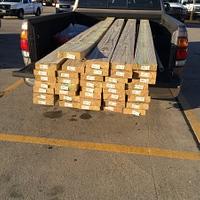
Shin
in almost 11 years
Outdoor Furniture Clear Finish of Choice?
Howdy, All!!!
Shin here. Been a while, as I’ve been wrapped up on converting the motorcycle to a trike. Bum ankle, so the wife and I want something that I can’t let fall over. :-)
We’ve also been clearing a bunch of brush, as we’ve applied for a Grassland Restoration Incentive Grant and were approved. We’re converting the “Front 40” back to native grasses and flowers, so the brush and Coastal Bermuda have to go.
Selena’ looking ahead and wants a new porch swing, to replace the Walmart special that’s going down hill. We’re going to build it and don’t want to paint it, but rather clear it, but I’m not sure what to go with. I’ve never clear coated outdoor furniture before.
I’m thinking tung oil. Thoughts or suggestions?
Thanks! Shin
Keith "Shin" Schindler
7 Replies
I would stay with oil.
Now I never tried oil for outdoor, but I tried varnish on my backyard table.
Now it need refinishing. I have to sand it first…
Abbas, Castro Valley, CA
I would also like to know.
Pretty much finish is going to need repair/restore work after a while. But the best true marine spar varnishes (such as Epifanes) are going to last longer and do much better. Use something (anything) from a box store and it may make it 6 months, most of them have urethane resins which just don’t do well outdoors. If you can still buy oil based paints a good choice that would be long lasting, quite a but cheaper, and a little easier to apply would be an untinted paint base. The exterior oil base made for dark colors (usually #4, but ask) will dry clear, have the UV and good weather resistance. Some of the acrylic outdoor paint base (again, the ones for dark colors) also dry clear. By clear I mean the oils will like all the world like an oil based varnish…an amber tone. the acrylics (waterbornes) will be water clear, at least the 2 I’ve seen: Olympic Premium High Gloss enamel, and SW A-100 exterior. If any of this may be of interest, here’s more info.
"I long for the day when coke was a cola and a joint was a bad place to be" Merle Haggartd
Oil and religion.
The former would be a non-hardening oil, since a hardening oil would block all but surface coat applications and they are far from tolerant of water.
The latter would be with regard to maintenance. The more religious you are early on, the better the results you will get.
I built a garage door from leavings I picked up from a cedar mill spalt pile. I applied a coat of used motor oil thinned about twenty percent. Within a month, you could hardly tell I’d done anything. The second coat reacted similarly. The third, however, was notable several years later. In short, the oil coats are cumulative. Rather than evaporate off, the oil wicks in and more can be added.
If a chunk of wood is saturated with oil, water isn’t going to penetrate it. Saturated with oil, it’s not going to dry as quickly, so will be far less to shrinking and cracking. It will remain resilient, rather than brittle, like cedar shakes and shingles get in the hot summer sun [but wouldn’t, if they were well oiled].
Oil will even swell old, dried wood and hide much of the splitting and cracking.
My preference would be to thin the oil about thirty percent. Ideally, it would be with turpentine, but paint thinner will do.
Now, on to my latest experiments.
I have been gathering the pitch from a pine tree in our yard for a while. My plan was to clean it up and add turpentine and hardening oil to make a finish. Just for the fun of it.
After a trip to a local museum, I was inspired to pick up the project again. However, I wasn’t ready to break out a double boiler [outside]. Instead, I stopped at a local horsey place and grabbed a can of pure pine tar, some BLO and my can of turpentine.
That mix is what a lot of gun stocks were treated with and they, obviously, held up well, and were easy to maintain and repair.
Many use this mix for their garden tool handles. I’m giving it a test drive on them and one of my wife’s wooden benches.
I believe the turpentine is crucial. Part of this is because it seems to, to some degree, contribute to the penetrating finish. I have three cans that have sat for a long while and have a tar like residue. Too, the gallon I had been saving was headed that way. In short, it has resins that are left behind after it gasses off (take that, California).
The coats I applied seem to penetrate will and the big rain we just had beaded off well.
The “finish” is ready to use in a couple days. It’s penetrating, so it doesn’t leave a glossing coat you would have to remove for future maintenance. Just like on a gun stock, it provides a nice gripping surface, but doesn’t come off on your hands.
Most wipe off the excess. However, too many waste valuable product doing this with things like mineral oil and this product. I like to let it soak in as much as possible. With non-hardening oil, you could come back days later and wipe off the excess. This this, I would give it hours, or even come back the next day and, if any hadn’t soaked in, wipe it off with mineral oil [if only so I could make some more self combusting rags]. ;)
Whatever product you choose,one should always know the maintenance regime. Not much point in getting something quick and easy only to have to sand the whole surface off when it breaks down. Whilst you want a clear finish Shin, if there is some pigmentation, the better the protection. One would work with the colour of the timber to highlight it and once finished it will actually look like a clear. It will depend on the colour of the timber. Whatever you choose, obtain one where you can just clean the surface of dust and reapply another coat with minimal fuss. In my opinion penetrating oils with pigments offer good protection and nourish the timber at the same time. If you do not keep your maintenance regime going, every product breaks down and will cause the timber to grey off and splinter.
The Livos Lady












